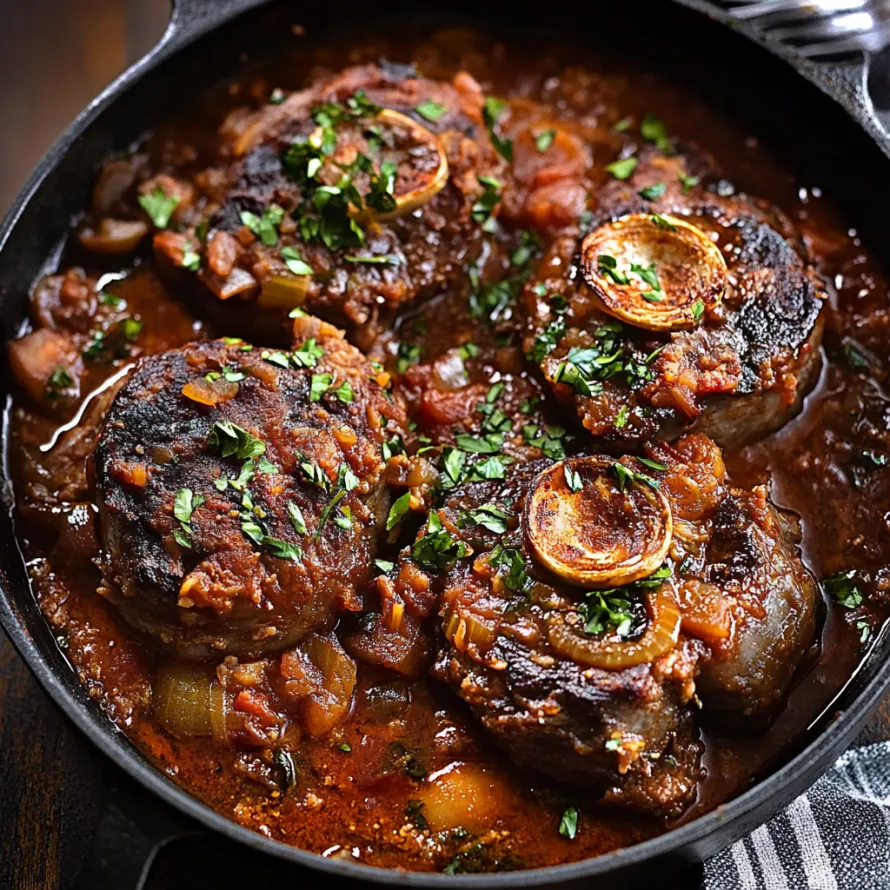 Save
Save
This timeless Italian dish transforms tough veal shanks into incredibly tender meat swimming in a rich, flavorful sauce. The name literally means "bone with a hole," pointing to the delicious marrow inside that becomes the crowning glory of this slow-cooked treasure.
I cooked this for my hubby on our special day, and it's now our go-to celebration meal. As it simmers, the kitchen fills with the most amazing smell, making everyone eager for that first bite.
What You'll Need
- Veal shanks: They should be around 2-3 inches thick. You'll want the cross-cut pieces with the bone right in the middle for the real deal. Go for shanks with nice fat marbling and bright pinkish meat.
- Pancetta or bacon: These add wonderful salty flavor to your sauce base. If you want something lighter, just swap in some olive oil instead.
- Mirepoix: That's just a fancy way of saying carrots, onions, and celery. Take your time cooking these down.
- Fresh herbs: Stuff like thyme and rosemary that give the sauce an earthy kick. Dried works too if that's what you've got.
- Dry wine: This loosens all the tasty bits stuck to the pan and balances the richness. Pick one you'd happily drink.
- Stock: Gives the sauce its backbone. Veal stock is the classic choice, but chicken or beef stock works great too.
- Tomatoes: They bring a nice sweet-tangy balance. San Marzano ones taste the best if you can find them.
- Flour: Helps get a nice brown crust on the meat and makes the sauce a bit thicker. Just a light coating will do the trick.
Foolproof Cooking Method
- Get Your Meat Ready:
- Throw lots of salt and pepper on those veal shanks, then give them a light dust of flour. This makes a gorgeous crust and thickens your sauce later. Don't rush this part - good seasoning makes all the difference.
- Cook the Pancetta:
- Drop your chopped pancetta in a pot over medium heat until it's golden and crunchy, about 5-7 minutes. The fat that comes out will flavor everything else. Save those crispy bits for later.
- Sear Your Veal:
- Turn up the heat to medium-high and brown those shanks until they're dark on all sides, roughly 5 minutes each side. This browning is where tons of flavor comes from. Do them one at a time if your pot's too small.
- Create Your Flavor Base:
- Toss in your chopped onions, carrots, celery, garlic, and herbs. Let them cook until soft and slightly brown, about 5-7 minutes. This sweet base cuts through the rich meat perfectly.
- Put It All Together:
- Put the meat and pancetta back in, pour in wine and tomatoes. Add enough stock to reach halfway up the shanks. Make sure to scrape the bottom good to get all those tasty bits unstuck.
- Let It Braise:
- Cover and stick it in a 325°F oven for about 1 to 1½ hours until you can easily stick a fork in the meat but it's not falling apart. The tough bits in the shanks will slowly melt into the sauce.
- Make Your Sauce Perfect:
- Take out the shanks and cook down the sauce on the stove until it thickens up a bit, around 5-10 minutes. This makes all the flavors stronger and gives you the perfect sauce to pour over your meat.
- Finish With Care:
- Pour that yummy sauce over your shanks and sprinkle with fresh parsley. The bright green herbs cut through all that richness and make it look pretty too.

Once I nearly skipped putting flour on the meat, thinking it wasn't important. Boy would that have been a mistake! That little bit of flour makes the sauce just right and helps the meat brown perfectly. I always do it now.
Cook It Ahead
This dish actually gets tastier with time. You can make it up to two days before you need it, keep it in the fridge, then warm it up slowly on the stove or in a 325°F oven. The flavors get deeper and mix together beautifully as it sits. Just scrape off any hard fat from the top before warming it up.
Perfect Side Dishes
In Milan, folks usually serve this with saffron risotto, which goes great with the rich meat. The creamy rice soaks up all that wonderful sauce. Smooth polenta or mashed potatoes work great too. Don't forget to add fresh gremolata on top - that's just chopped parsley, lemon zest, and garlic mixed together - it adds a fresh pop to cut through the richness.
Finding The Best Meat
You need veal shanks for the real deal, but beef shanks work fine if you can't get veal. Look for pieces about 2-3 inches thick with the bone in the middle. That bone adds tons of flavor and the marrow turns buttery soft while cooking. Your butcher can cut them the right thickness if you ask.

This beautiful osso buco will surely be the star of any dinner party. Treat the people you care about to this incredible Italian favorite.
Common Recipe Questions
- → What cut of meat is used for Osso Buco?
Osso Buco normally uses veal shanks cut across into 2-3 inch thick slices. The name 'osso buco' actually means 'bone with a hole' in Italian, talking about the marrow hole in the middle of the shank. While veal is the traditional choice, you can swap in beef shanks instead, but they'll need more time to cook properly.
- → What is the best cooking method for Osso Buco?
The top way to cook Osso Buco is by slow braising. This means first browning the meat, then cooking it slowly in liquid at a low heat (about 325°F) in a covered Dutch oven or heavy pot. This slow, gentle cooking breaks down the tough bits in the shanks, making the meat super tender and creating a thick, tasty sauce.
- → What wines pair well with Osso Buco?
Osso Buco tastes great with medium to full-bodied red wines that have enough tang to balance the richness of the food. Great options include Italian reds like Barolo, Barbaresco, Chianti Classico, or Valpolicella. If you like white wine better, a rich white like a good Chardonnay or Soave would work nicely with the dish too.
- → Can Osso Buco be made ahead of time?
For sure, Osso Buco actually gets better when made ahead of time. The flavors mix and grow stronger as the dish sits. You can make it up to 2-3 days before and keep it in the fridge after it cools down. When you want to eat it, just warm it up gently in a 325°F oven until it's hot through. Many cooks think Osso Buco tastes way better the next day.
- → What is traditionally served with Osso Buco?
Osso Buco usually comes with risotto alla Milanese, a saffron-flavored rice dish that goes perfectly with the rich flavors. Other good sides include creamy polenta, mashed potatoes, or crusty bread to soak up all the yummy sauce. A simple mix of lemon zest, garlic, and parsley called gremolata is often sprinkled on top right before serving to add a fresh kick.
- → How do you know when Osso Buco is done cooking?
Osso Buco is ready when the meat is so tender you can cut it with a fork and it's almost falling off the bone. You should be able to stick a fork in it easily with hardly any resistance. The tough parts in the shanks should have melted away, making the sauce smooth and silky. Veal shanks usually get this tender after 1-1½ hours of braising, while beef shanks might take 2-3 hours. The meat should reach 145°F inside for veal.
